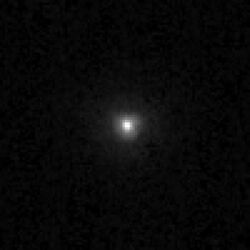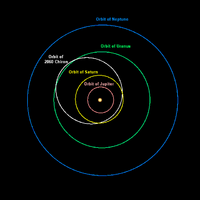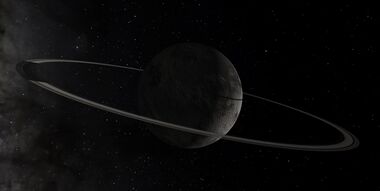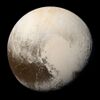Astronomy:2060 Chiron
 Hubble Space Telescope image of Chiron and its coma, taken in 1996 | |
| Discovery[1][2][3] | |
|---|---|
| Discovered by | Charles Kowal |
| Discovery site | Palomar Observatory |
| Discovery date | 1 November 1977 |
| Designations | |
| |
| Pronunciation | /ˈkaɪrɒn/ |
| Named after | Chiron (Greek mythology)[5] |
| 1977 UB | |
| Minor planet category | |
| Adjectives |
|
| Orbital characteristics[6] | |
| Epoch 2021-Jul-01 (JD 2459396.5) | |
| Uncertainty parameter 0 | |
| Observation arc | 126.29 yr |
| Earliest precovery date | 24 April 1895[1] (Harvard Observatory) |
| |{{{apsis}}}|helion}} | 18.87 astronomical unit|AU (2.8 billion km) (occurred May 2021)[8] |
| |{{{apsis}}}|helion}} | 8.533 AU (1.3 billion km) |
| 13.70 AU (2.0 billion km) | |
| Eccentricity | 0.3772 |
| Orbital period | 50.71 yr (18,523 days) |
| Average Orbital speed | 7.75 km/s |
| Mean anomaly | 180.70° |
| Mean motion | 0° 1m 10.2s / day |
| Inclination | 6.9299° |
| Longitude of ascending node | 209.27° |
| |{{{apsis}}}|helion}} | |
| 339.71° | |
| Jupiter MOID | 3.1 AU (460 million km) |
| Saturn MOID | 0.48 AU (72 million km)[1] |
| Uranus MOID | 1.4 AU (210 million km)[1] |
| TJupiter | 3.363 |
| Physical characteristics | |
| Mean radius | |
| Rotation period | 5.918 h[13][14][15][16][17] |
| Geometric albedo | |
| Apparent magnitude | 18.93[20] 14.9 (Perihelic opposition)[21] |
| Absolute magnitude (H) | |
| Angular diameter | 0.035" (max)[26] |
2060 Chiron is a small Solar System body in the outer Solar System, orbiting the Sun between Saturn and Uranus. Discovered in 1977 by Charles Kowal, it was the first-identified member of a new class of objects now known as centaurs—bodies orbiting between the asteroid belt and the Kuiper belt.[lower-alpha 1]
Although it was initially called an asteroid and classified only as a minor planet with the designation "2060 Chiron", in 1989 it was found to exhibit behavior typical of a comet. Today it is classified as both a minor planet and a comet, and is accordingly also known by the cometary designation 95P/Chiron. Chiron is named after the centaur Chiron in Greek mythology.[1]
History
Discovery
Chiron was discovered on 1 November 1977 by Charles Kowal from images taken on 18 October at Palomar Observatory.[2][3] It was given the temporary designation of 1977 UB.[27] It was found near aphelion[2] and at the time of discovery it was the most distant known minor planet.[lower-alpha 2][27] Chiron was even claimed as the tenth planet by the press.[28] Chiron was later found on several precovery images, going back to 1895,[29] which allowed its orbit to be accurately determined.[2] It had been at perihelion in 1945 but was not discovered then because there were few searches being made at that time, and these were not sensitive to slow-moving objects. The Lowell Observatory's survey for distant planets would not have gone down faint enough in the 1930s and did not cover the right region of the sky in the 1940s.[2] The April 1895 precovery image was one month after the March 1895 perihelion.[10]
Naming
This minor planet was named after Chiron, a half-human, half-horse centaur from Greek mythology. Son of the Titan Cronus and the nymph Philyra, Chiron was the wisest and most just of all centaurs, serving as an instructor of the Greek heroes.[5] The official naming citation was published by the Minor Planet Center on 1 April 1978 (M.P.C. 4359).[5][30] It was suggested that the names of other centaurs be reserved for objects of the same type.[2]
Chiron, along with most major and minor planetary bodies, is not generally given a symbol in astronomy. A symbol ![]() was devised for it by Al H. Morrison and is mostly used among astrologers: it resembles a key as well as an OK monogram for Object Kowal.[31][32]
was devised for it by Al H. Morrison and is mostly used among astrologers: it resembles a key as well as an OK monogram for Object Kowal.[31][32]
Orbit
Chiron's orbit was found to be highly eccentric (0.37), with perihelion just inside the orbit of Saturn and aphelion just outside the perihelion of Uranus (it does not reach the average distance of Uranus, however). According to the program Solex, Chiron's closest approach to Saturn in modern times was around May 720, when it came within 30.5±2.0 million km (0.204 ± 0.013 AU) of Saturn. During this passage Saturn's gravity caused Chiron's semi-major axis to decrease from 14.55±0.12 AU[33] to 13.7 AU.[6] Chiron's orbit does not intersect Uranus'.
Chiron attracted considerable interest because it was the first object discovered in such an orbit, well outside the asteroid belt. Chiron is classified as a centaur, the first of a class of objects orbiting between the outer planets. Chiron is a Saturn–Uranus object because its perihelion lies in Saturn's zone of control and its aphelion lies in that of Uranus.[34] Centaurs are not in stable orbits and will be removed by gravitational perturbation by the giant planets over a period of millions of years, moving to different orbits or leaving the Solar System altogether.[35] Chiron is probably from the Kuiper belt and will probably become a short-period comet in about a million years.[34] Chiron came to perihelion (closest point to the Sun) in 1996 and aphelion in May 2021.[8]
Physical characteristics
Spectral type
The visible and near-infrared spectrum of Chiron is neutral,[27] and is similar to that of C-type asteroids and the nucleus of Halley's Comet.[15] The near-infrared spectrum of Chiron shows absence of water ice.[36]
Rotation period
Four rotational light curves of Chiron were taken from photometric observations between 1989 and 1997. Lightcurve analysis gave a concurring, well-defined rotational period of 5.918 hours with a small brightness variation of 0.05 to 0.09 magnitude, which indicates that the body has a rather spheroidal shape ({{{1}}}).[13][14][15][16][17]
Diameter
| Year | Diameter | Notes | Refs |
|---|---|---|---|
| 1984 | 180 km | Lebofsky (1984) | [37] |
| 1991 | 186 km | IRAS | [37] |
| 1994 | 188 km | Campins (radius 94±6 km) | [27] |
| 1996 | 180 km | occultation | [37] |
| 1998 | 166 km | Dunham occultation list (Dunham 1998) |
[6] |
| 2007 | 233 km | Spitzer Space Telescope | [12] |
| 2013 | 218 km | Herschel Space Observatory (PACS and SPIRE) |
[11] |
| 2017 | 271 km | LCDB | [13] |
| 2017 | 206 km | Brown | [18] |
The assumed size of an object depends on its absolute magnitude (H) and the albedo (the amount of light it reflects). In 1984 Lebofsky estimated Chiron to be about 180 km in diameter.[37] Estimates in the 1990s were closer to 150 km in diameter.[6][37] Occultation data from 1993 suggests a diameter of about 180 km.[37] Combined data from the Spitzer Space Telescope in 2007 and the Herschel Space Observatory in 2011 suggests that Chiron is 218±20 km in diameter.[11] Therefore, Chiron may be as large as 10199 Chariklo.[12] The diameter of Chiron is difficult to estimate in part because the true absolute magnitude of its nucleus is uncertain due to its highly variable cometary activity.[11]
Cometary behavior
In February 1988, at 12 AU from the Sun, Chiron brightened by 75 percent.[38] This is behavior typical of comets but not asteroids. Further observations in April 1989 showed that Chiron had developed a cometary coma,[39] A tail was detected in 1993.[27] Chiron differs from other comets in that water is not a major component of its coma, because it is too far from the Sun for water to sublimate.[40] In 1995 carbon monoxide was detected in Chiron in very small amounts, and the derived CO production rate was calculated to be sufficient to account for the observed coma.[41] Cyanide was also detected in the spectrum of Chiron in 1991.[42] At the time of its discovery, Chiron was close to aphelion, whereas the observations showing a coma were done closer to perihelion, perhaps explaining why no cometary behavior had been seen earlier. The fact that Chiron is still active probably means it has not been in its current orbit very long.[29]
Chiron is officially designated as both a comet—95P/Chiron—and a minor planet,[4][11] an indication of the sometimes fuzzy dividing line between the two classes of object. The term proto-comet has also been used. Being about 220 km in diameter, it is unusually large for a comet nucleus. Chiron was the first member of a new family of Chiron-type comets (CTC) with (TJupiter > 3; a > aJupiter).[6] Other CTCs include: 39P/Oterma, 165P/LINEAR, 166P/NEAT, and 167P/CINEOS. There are also non-centaur asteroids that are simultaneously classified as comets, such as 4015 Wilson–Harrington, 7968 Elst–Pizarro, and 118401 LINEAR.[4] Michael Brown lists it as possibly a dwarf planet with a measured diameter of 200 km (120 mi),[18] which may be near the lower limit for an icy object to have been a dwarf planet at some point in its history.
Since the discovery of Chiron, other centaurs have been discovered, and nearly all are currently classified as minor planets, but are being observed for possible cometary behavior. 60558 Echeclus has displayed a cometary coma and now also has the cometary designation 174P/Echeclus. After passing perihelion in early 2008, 52872 Okyrhoe significantly brightened.[43]
Rings
Chiron has rings, similar to the better-established rings of 10199 Chariklo.[44][45][46][lower-alpha 3] Based on unexpected occultation events observed in stellar-occultation data obtained on 7 November 1993, 9 March 1994, and 29 November 2011, which were initially interpreted as resulting from jets associated with Chiron's comet-like activity, Chiron's rings were proposed to be 324±10 km in radius and sharply defined. The rings' changing appearance at different viewing angles can largely explain the long-term variation in Chiron's brightness and hence estimates of Chiron's albedo and size. Moreover, it can, by assuming that the water ice is in Chiron's rings, explain the changing intensity of the infrared water-ice absorption bands in Chiron's spectrum, including their disappearance in 2001 (when the rings were edge-on). Also, the geometric albedo of Chiron's rings as determined by spectroscopy is consistent with that used to explain Chiron's long-term brightness variations.[44]
Further evidence of the rings was provided by two independent observations of occultations on 28 November 2018 and 15 December 2022, which suggests that their structure is constantly evolving.[47] In the 2018 event Chiron's rings were observed to have less material than in 2011, but seemed to be developing a partial third ring; by the 2022 event there was more material than either of the previous observations, and the third ring had fully developed.[48] J.L. Ortiz speculated that the extra material in the 2022 event could be from an outburst observed in 2021, which left more material in orbit and thus bolstered the generation of the third ring–this is also expected to be cyclical, maintaining the rings.[47] However, Sickafoose saw no connection.
The preferred pole of Chiron's rings is, in ecliptic coordinates, λ = 151°±8°, β = 18°±11°. The rings' width, separation, and optical depths were observed to be nearly identical to those of Chariklo's rings until the 2018 observation, indicating that the same type of structure had been responsible for both. Moreover, both their rings are within their respective Roche limits, though Chiron's newly developed third ring may be outside of it depending on its density.[44][47]
Exploration
The Chiron Orbiter Mission is a mission proposed for NASA's New Frontiers program or Flagship program. It was published in May 2010 and proposes an orbiter mission to Chiron. Its launch date could vary from as early as 2023 to as late as 2025, depending on budget and propulsion type.[49]
There is another mission proposed, part of the Discovery Program known as Centaurus; if approved it would launch between 2026 and 2029 and make a flyby of 2060 Chiron and one other Centaur sometime in the 2030s.
Gallery
| Wikimedia Commons has media related to 2060 Chiron. |
See also
- List of centaurs (small Solar System bodies) § 2060
- List of Solar System objects by size
- Lists of small Solar System bodies
Notes
- ↑ 944 Hidalgo, discovered in 1920, also fits this definition, but was not identified as belonging to a distinct population.
- ↑ Pluto, now considered to be a dwarf planet and hence a minor planet, was known at the time, but was considered a planet.
- ↑ A stellar occultation in 2017 of another minor planet, Haumea (a trans-Neptunian object), indicated the presence of a ring.
References
- ↑ 1.0 1.1 1.2 1.3 1.4 1.5 "2060 Chiron (1977 UB)". Minor Planet Center. https://www.minorplanetcenter.net/db_search/show_object?object_id=2060.
- ↑ 2.0 2.1 2.2 2.3 2.4 2.5 "The discovery and orbit of /2060/ Chiron". In: Dynamics of the Solar System; Proceedings of the Symposium, Tokyo, Japan, May 23–26, 1978 81: 245–250. December 1978. Bibcode: 1979IAUS...81..245K.
- ↑ 3.0 3.1 "Chiron Fact Sheet". 20 August 2014. http://nssdc.gsfc.nasa.gov/planetary/factsheet/chironfact.html.
- ↑ 4.0 4.1 4.2 "Dual-Status Objects". Minor Planet Center. http://www.minorplanetcenter.org/iau/lists/DualStatus.html.
- ↑ 5.0 5.1 5.2 "(2060) Chiron". Dictionary of Minor Planet Names – (2060) Chiron. Springer Berlin Heidelberg. 2007. p. 167. doi:10.1007/978-3-540-29925-7_2061. ISBN 978-3-540-00238-3.
- ↑ 6.0 6.1 6.2 6.3 6.4 6.5 6.6 6.7 6.8 6.9 "JPL Small-Body Database Browser: 2060 Chiron (1977 UB)". Jet Propulsion Laboratory. https://ssd.jpl.nasa.gov/sbdb.cgi?sstr=2002060.
- ↑ "List of Centaurs and Scattered-Disk Objects". Minor Planet Center. https://www.minorplanetcenter.net/iau/lists/Centaurs.html.
- ↑ 8.0 8.1 "Horizons Batch for 2060 Chiron (1977 UB) on 2021-May-27". JPL Horizons. https://ssd.jpl.nasa.gov/horizons_batch.cgi?batch=1&COMMAND=%272060%27&START_TIME=%272021-05-25%27&STOP_TIME=%272021-05-29%27&STEP_SIZE=%271%20hours%27&QUANTITIES=%2719%27. Retrieved 2021-10-03.
- ↑ "Horizons Batch for 2060 Chiron (1977 UB) on 2046-Aug-03". JPL Horizons. https://ssd.jpl.nasa.gov/horizons_batch.cgi?batch=1&COMMAND=%272060%27&START_TIME=%272046-07-25%27&STOP_TIME=%272046-08-12%27&STEP_SIZE=%273%20hours%27&QUANTITIES=%2719,22%27. Retrieved 2021-10-01.
- ↑ 10.0 10.1 "Horizons Batch for 2060 Chiron (1977 UB) on 1895-Mar-16". JPL Horizons. https://ssd.jpl.nasa.gov/horizons_batch.cgi?batch=1&COMMAND=%272060%27&START_TIME=%271895-03-12%27&STOP_TIME=%271895-03-20%27&STEP_SIZE=%271%20hours%27&QUANTITIES=%2719%27. Retrieved 2021-10-03.
- ↑ 11.0 11.1 11.2 11.3 11.4 11.5 11.6 "TNOs are Cool: A survey of the trans-Neptunian region. VIII. Combined Herschel PACS and SPIRE observations of nine bright targets at 70-500 mum". Astronomy and Astrophysics 555: 22. July 2013. doi:10.1051/0004-6361/201321329. Bibcode: 2013A&A...555A..15F.
- ↑ 12.0 12.1 12.2 Stansberry, John; Grundy, Will; Brown, Michael E.; Cruikshank, Dale P.; Spencer, John; Trilling, David; Margot, Jean-Luc (November 2007). "Physical Properties of Kuiper Belt and Centaur Objects: Constraints from Spitzer Space Telescope". arXiv:astro-ph/0702538.
- ↑ 13.0 13.1 13.2 13.3 13.4 13.5 13.6 "LCDB Data for (2060) Chiron". Asteroid Lightcurve Database (LCDB). http://www.minorplanet.info/PHP/generateOneAsteroidInfo.php?AstInfo=2060%7CChiron.
- ↑ 14.0 14.1 Bus, Schelte J.; Bowell, Edward L. G. (February 1989). "2060 Chiron - CCD and electronographic photometry". Icarus 77 (2): 223–238. doi:10.1016/0019-1035(89)90087-0. ISSN 0019-1035. Bibcode: 1989Icar...77..223B.
- ↑ 15.0 15.1 15.2 Luu, Jane X.; Jewitt, David C. (September 1990). "Cometary activity in 2060 Chiron". Astronomical Journal 100: 913–932. doi:10.1086/115571. ISSN 0004-6256. Bibcode: 1990AJ....100..913L.
- ↑ 16.0 16.1 Marcialis, Robert L.; Buratti, Bonnie J. (August 1993). "CCD photometry of 2060 Chiron in 1985 and 1991". Icarus 104 (2): 234–243. doi:10.1006/icar.1993.1098. ISSN 0019-1035. Bibcode: 1993Icar..104..234M.
- ↑ 17.0 17.1 17.2 Lazzaro, Daniela; Florczak, Marcos A.; Angeli, Cláudia A.; Carvano, Jorge Márcio F.; Betzler, Alberto S.; Casati, A. A. et al. (December 1997). "Photometric monitoring of 2060 Chiron's brightness at perihelion". Planetary and Space Science 45 (12): 1607–1614. doi:10.1016/S0032-0633(97)00124-4. Bibcode: 1997P&SS...45.1607L.
- ↑ 18.0 18.1 18.2 18.3 "How many dwarf planets are there in the outer solar system?". California Institute of Technology. http://web.gps.caltech.edu/~mbrown/dps.html.
- ↑ Belskaya, Irina N.; Barucci, Maria Antonietta; Fulchignoni, Marcello; Dovgopol, Anatolij N. (April 2015). "Updated taxonomy of trans-Neptunian objects and centaurs: Influence of albedo". Icarus 250: 482–491. doi:10.1016/j.icarus.2014.12.004. Bibcode: 2015Icar..250..482B.
- ↑ "AstDys (2060) Chiron Ephemerides". Department of Mathematics, University of Pisa, Italy. https://newton.spacedys.com/astdys/index.php?pc=1.1.3.0&n=2060.
- ↑ "Chiron Apmag March-April 1996". JPL Horizons. https://ssd.jpl.nasa.gov/horizons_batch.cgi?batch=1&COMMAND=%27Chiron%27&START_TIME=%271996-03-20%27&STOP_TIME=%271996-04-10%27&STEP_SIZE=%273%20hours%27&QUANTITIES=%279,19%27. Retrieved 2021-07-06.
- ↑ Veres, Peter; Jedicke, Robert; Fitzsimmons, Alan; Denneau, Larry; Granvik, Mikael; Bolin, Bryce et al. (November 2015). "Absolute magnitudes and slope parameters for 250,000 asteroids observed by Pan-STARRS PS1 - Preliminary results". Icarus 261: 34–47. doi:10.1016/j.icarus.2015.08.007. Bibcode: 2015Icar..261...34V.
- ↑ "Polarimetry of Centaurs (2060) Chiron, (5145) Pholus and (10199) Chariklo". Icarus 210 (1): 472–479. November 2010. doi:10.1016/j.icarus.2010.06.005. Bibcode: 2010Icar..210..472B.
- ↑ Peixinho, Nuno; Delsanti, Audrey C.; Guilbert-Lepoutre, Aurélie; Gafeira, Ricardo; Lacerda, Pedro (October 2012). "The bimodal colors of Centaurs and small Kuiper belt objects". Astronomy and Astrophysics 546: 12. doi:10.1051/0004-6361/201219057. Bibcode: 2012A&A...546A..86P.
- ↑ "Visible and Infrared Photometry of Six Centaurs". Icarus 134 (2): 213–227. August 1998. doi:10.1006/icar.1998.5931. Bibcode: 1998Icar..134..213D.
- ↑ Meech, Karen J. (19 February 1994). "The Structure of the Inner Coma of Comet Chiron: Imaging The Exopause". Institute for Astronomy, University of Hawaii. http://www.stecf.org/poa/FOS/props/3769c.prop.
- ↑ 27.0 27.1 27.2 27.3 27.4 Campins, Humberto; Telesco, Charles M.; Osip, David J. (December 1994). "The color temperature of (2060) Chiron: A warm and small nucleus". Astronomical Journal 108: 2318–2322. doi:10.1086/117244. ISSN 0004-6256. Bibcode: 1994AJ....108.2318C.
- ↑ Collander-Brown, Simon J.; Maran, Michael D.; Williams, Iwan P. (2000). "The effect on the Edgeworth-Kuiper Belt of a large distant tenth planet". Monthly Notices of the Royal Astronomical Society 318 (1): 101–108. doi:10.1046/j.1365-8711.2000.t01-1-03640.x. Bibcode: 2000MNRAS.318..101C.
- ↑ 29.0 29.1 "The Chiron Perihelion Campaign". 2003-12-11. http://nssdc.gsfc.nasa.gov/planetary/chiron.html.
- ↑ Schmadel, Lutz D. (2009). "Appendix – Publication Dates of the MPCs". Dictionary of Minor Planet Names – Addendum to Fifth Edition (2006–2008). Springer Berlin Heidelberg. p. 221. doi:10.1007/978-3-642-01965-4. ISBN 978-3-642-01964-7. Bibcode: 2009dmpn.book.....S. https://archive.org/details/dictionaryminorp2008schm.
- ↑ Morrison, Al H. (1977). "Chiron". CAO Times 3: 57.
- ↑ Miller & Stein (2021) Comment on U+26B7 CHIRON L2/21-225, UTC Document Registry
- ↑ "Chiron's Osculating Elements 700AD generated with Solex 11, and data of close approach in 720". https://upload.wikimedia.org/wikipedia/commons/e/ec/ChironSaturnApproach.jpg. "Solex 10 results". http://home.surewest.net/kheider/astro/Chiron700AD.gif.
- ↑ 34.0 34.1 Horner, Jonathan M.; Evans, Norman W.; Bailey, Mark E. S. (2004). "Simulations of the Population of Centaurs II: Individual Objects". Monthly Notices of the Royal Astronomical Society 355 (2): 321–329. doi:10.1111/j.1365-2966.2004.08342.x. Bibcode: 2004MNRAS.355..321H.
- ↑ "The Solar System Beyond The Planets". Solar System Update: Topical and Timely Reviews in Solar System Sciences. Springer-Praxis Ed.. 2006. ISBN 978-3-540-26056-1. "Preprint version". http://www.ifa.hawaii.edu/faculty/jewitt/papers/2006/DJ06.pdf.)
- ↑ "Water Ice in 2060 Chiron and Its Implications for Centaurs and Kuiper Belt Objects". The Astrophysical Journal 531 (2): L151–L154. March 2000. doi:10.1086/312536. PMID 10688775. Bibcode: 2000ApJ...531L.151L.
- ↑ 37.0 37.1 37.2 37.3 37.4 37.5 Groussin, Olivier; Lamy, Philippe; Jorda, Laurent (January 2004). "Properties of the nuclei of Centaurs Chiron and Chariklo". Astronomy and Astrophysics 413 (3): 1163–1175. doi:10.1051/0004-6361:20031564. Bibcode: 2004A&A...413.1163G. https://www.aanda.org/articles/aa/pdf/2004/03/aa3595.pdf. Retrieved 8 August 2017.
- ↑ "2060 Chiron - Colorimetry and cometary behavior". Icarus 83 (1): 1–15. January 1990. doi:10.1016/0019-1035(90)90002-Q. Bibcode: 1990Icar...83....1H.
- ↑ Meech, Karen J. (April 1989). "(2060) Chiron". IAU Circular 4770: 1. Bibcode: 1989IAUC.4770....1M.
- ↑ Meech, Karen J.; Belton, Michael J. S. (October 1990). "The Atmosphere of 2060 Chiron". The Astronomical Journal 100: 1323–1338. doi:10.1086/115600. Bibcode: 1990AJ....100.1323M.
- ↑ Womack, Maria; Stern, Alan (1999). "Observations of Carbon Monoxide in (2060) Chiron". 28th Lunar and Planetary Science Conference, Houston, TX, Mar. 17-21, 1997. http://www.lpi.usra.edu/meetings/lpsc97/pdf/1492.PDF. Retrieved 2017-07-11.
- ↑ "Detection of CN Emission from (2060) Chiron". Science 251 (4995): 774–777. 15 February 1991. doi:10.1126/science.251.4995.774. PMID 17775455. Bibcode: 1991Sci...251..774B.
- ↑ Trigo-Rodríguez, Josep M.; García Melendo, Enrique; García-Hernández, Domingo Aníbal; Davidsson, Björn J. R.; Sánchez, Albert; Rodriguez, Diego (2008). "A continuous follow-up of Centaurs, and dormant comets: looking for cometary activity.". 3rd European Planetary Science Congress 2008. http://www.cosis.net/abstracts/EPSC2008/00291/EPSC2008-A-00291-1.pdf. Retrieved 2008-10-12.
- ↑ 44.0 44.1 44.2 Ortiz Moreno, José Luis; Duffard, René Damián; Pinilla-Alonso, Noemi; Alvarez-Candal, Alvaro; Santos-Sanz, Pablo; Morales Palomino, Nicolás Francisco; Fernández-Valenzuela, Estela del Mar; Licandro, Javier et al. (2015). "Possible ring material around centaur (2060) Chiron". Astronomy & Astrophysics 576: A18. doi:10.1051/0004-6361/201424461. Bibcode: 2015A&A...576A..18O.
- ↑ Lakdawalla, Emily (2015-01-27). "A second ringed centaur? Centaurs with rings could be common". Planetary Society. http://www.planetary.org/blogs/emily-lakdawalla/2015/01271038-a-second-ringed-centaur.html.
- ↑ "A second minor planet may possess Saturn-like rings". Space Daily. 17 March 2015. http://www.spacedaily.com/reports/A_second_minor_planet_may_possess_Saturn_like_rings_999.html.
- ↑ 47.0 47.1 47.2 Ortiz, J. L.; Pereira, C. L.; Sicardy, P. (7 August 2023). "The changing material around (2060) Chiron from an occultation on 2022 December 15". Astronomy & Astrophysics. doi:10.1051/0004-6361/202347025.
- ↑ Sickafoose, Amanda A.; Levine, Stephen E.; Bosh, Amanda S.; Person, Michael J.; Zuluaga, Carlos A.; Knieling, Bastian; Lewis, Mark C.; Schindler, Karsten (1 November 2023). "Material around the Centaur (2060) Chiron from the 2018 November 28 UT Stellar Occultation". The Planetary Science Journal 4 (11): 221. doi:10.3847/PSJ/ad0632. Bibcode: 2023PSJ.....4..221S.
- ↑ "Chiron Orbiter Mission Concept Study". https://archive.org/details/ChironOrbiterMissionConceptStudy.
Further reading
- Fernández, Yanga R.; Jewitt, David C.; Sheppard, Scott S. (2002). "Thermal Properties of Centaurs Asbolus and Chiron". Astronomical Journal 123 (2): 1050–1055. doi:10.1086/338436. Bibcode: 2002AJ....123.1050F.
- Moore, Patrick; Guinness book of Astronomy, ISBN:0-85112-375-9
- SOLEX 9.1
External links
- Orbit Fit and Astrometric record for (2060) Chiron, Marc W. Buie, SwRI – Space Science Department (2007)
- 95P/Chiron at Cometography
- A single clone run of centaur 2060 Chiron showing how Chiron may someday become an active comet (Solex 10)
- 2060 Chiron at AstDyS-2, Asteroids—Dynamic Site
- 2060 Chiron at the JPL Small-Body Database
| Numbered comets | ||
|---|---|---|
| Previous 94P/Russell |
95P/Chiron | Next 96P/Machholz |
 |








